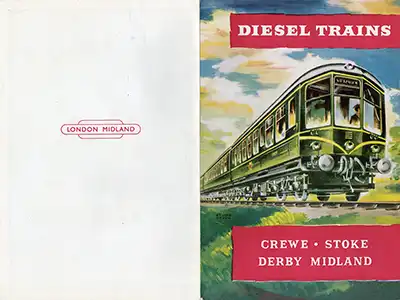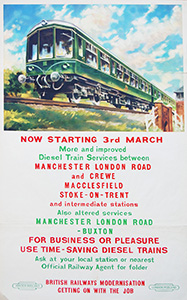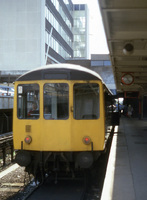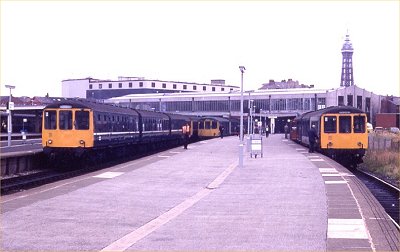Class 104 BRC&W 2, 3 & 4-car DMUs
Operations
New sets were delivered to the London Midland Region (188 vehicles — 10 2-car and 56 3-car sets) and North Eastern Region (114 vehicles — 5 2-car and 26 4-car sets).
One the many routes worked by the class, one they became synonymous with is the Buxton to Manchester Piccadilly 'Spa Line', another was the Manchester - Blackpool 'white-stripe' services.
Later years saw them spread to the Eastern, Western and Scottish Regions. A celebrity ScR set in the mid-1980s was the "Mexican Bean" which worked a summer Oban - Crainlarich tourist duty painted in a maroon and white livery.
The Class lasted in passenger use until the early 1990s, the London Midland Region having sets in service until 1990, after that it was just the Western Region operating vehicles in the London area until October 1993.
Early Days
The first four sets were delivered in April (two sets) and May 57 (two sets) to Longsight, the first of two batches of 3-car sets for the LMR.
An early sighting was 50420/59132/50424, with B1 on the route indicator, working from Longsight on the 20th April 1957.
Noted at Longsight on the 19th May 1957 were 50421/59133/50425 and 50423/59135/50427.
They were introduced to Manchester - Buxton service on the 17th June 1957, along with other blue square types. They replaced the Derby Lightweights (introduced to the line on 8 October 1956) which could not cope with the demanding gradients and conditions of the 'Spa Line'.
The second batch of 3-car sets, comprising 52 units for the LMR, would also begin to be delivered in 1957, starting in May with the final set arriving in March 1958.
Noted working the Manchester - Buxton - Crewe services on the 17th June 1957 were 50423/59135/50427, 50428/59136/50480, 50430/59138/50482 and 50431/59139/50483.
Crewe - Stoke - Derby Midland
On Monday 16th September 1957 sets were introduced on an improved service between Crewe and Derby via Stoke. A folded leaflet was made available to the public promoting the new trains:


Noted in use in the first days were 50435/59143/50487 and 50428/59136/50480. The only criticism they got was the noisy vibration of the luggage racks when in low gear.
At the same time a new fast diesel service was introduced to Llandudno. The journey from Chester took one hour, and was advertised as being the fastest timing ever to operate between those points. The service was also advertised locally under the name 'The Diesel Rapide'. It left Crewe at 11:15, all stations to Chester, then leaving at 11:55 for Prestatyn (26 mins), Rhyl, Colwyn Bay (46 mins), Llan. Jct & Llandudno. It returned on the previously steam 13:45 through to Derby, to greatly accelerated timings. On the first day it was worked by 50480/59136/50248. Not having Llandudno on the indicators, they simply carried a 'B', arriving exactly on time. It was packed leaving Crewe, with standing in the van, and a steam relief had to be provided to cope with the Chester passengers. The service was scheduled for 2x3-car sets, but Crewe was short of stock.
DMUs had worked the Sunday service on the Millers Dale - Buxton branch for some months before taking over the weekday operations on the 7th October 1957.
On a Sunday excursion working from Manchester to Newcastle on the 3rd November 1957 were 50449/59157/50501 & 50437/59145/50489.

The image shows a three-car set in Birmingham New Street beside a Derby Lightweight on December 16, 1957. M50458 at the front was just a few weeks old and allocated to 5D (Stoke). Michael Mensing.
The Manchester - Hayfield/Macclesfield services saw 198,303 passengers for a sample month in 1957, compared with 136,768 for the same month in 1956, an increase of 61,535. On the Crewe - Stoke - Derby service for the 1957 sample month there were 84,248 passengers were compared with 60,154 in 1956, an increase of 24,094.
The through DMU working on Sundays from Stoke (dep. 16:00) to Rugby (arr 18:38 and return 18:50) was worked by 3-car sets, and on the 26th January 1958 it was the turn of 50437/59145/50489.

This was a poster used to advertise the 3rd March 1958 enhanced services, scan courtesy of John Paton. John is predominately a collector of Scottish Region publicity material and is willing to swap this poster for ScR material. Get in touch if you are interested.
Extension and problems
At the end of January 1958 the LMR preliminarily announced an extension of DMU services from Manchester (London Rd) to take in Stoke, with an hourly service between the two centres. The new workings were due to begin on the 3rd Feb., but were called off due to a mechanical fault found with the Class 104 bogies, just 48 hours before they were due to begin. Forty-nine sets were taken out of service, and the remedial work was expected to take five weeks and it was hoped the new services would begin in early March. Met-Camm sets were borrowed from the NER, and ten 2-6-4s obtained from Willesden.
They did start on the 3rd March 1958. It made it possible to travel from Wolverhampton (High Level) at 09:06 and 18:23 to Birmingham New Street., via Bescot and Aston by trains which stopped at all stations, although there was not a similar service in the opposite direction.
Buxton Depot
The first four 3-car sets were re-allocated to the then new Buxton diesel depot on Feb 3, 1958 from Longsight, with more sets yet to come. The Class 104s would work the Buxton line for almost 32 years, 31 years of which Buxton constantly had its own allocation of 104s. Buxton allocated driving cars were instantly recognisable with their painted white cab roofs, which complemented the green (and later blue) livery well.
In mid-1958 the Birmingham - Leicester services were worked by 3-car 104s such as 50478 / 59186 / 50530 & Class 105s. On the 1/6/58 an Amateur Photographers excursion from Nottingham, Mansfield and Derby ran to Betws-y-Coed. It was formed of a 9-car set, six from Nottingham (Midland) - 50531 / 59187 / 50479 and Class 105 50754 / 59309 / 50787, and from Mansfield 50478 / 59186 / 50530. The train left Derby (Midland) at 08:40, arriving Betws-y-Coed at 12:10. It returned at 17:00, getting to Derby at 19:55, seven minutes late due to a dead stand at Crewe.
More Deliveries
Mid-1958 saw 15 power-trailer sets delivered, 10 to the LMR at Stoke and 5 to the NER at Bradford. These were followed by the the 4-car sets, a batch of 21 and a batch of 5, both to the NER, this concluded the deliveries of the type.
On 23/3/58 an excursion ran from Tyldesley to Scarborough, the train, W590, was comprised of 50483 + 59139 + 50431 / 50482 + 59138 + 50430.[1]
On Good Friday 1958 another excursion from Tyldesley to Scarborough had 50501 / 59157/ 50449 & 50502 / 59158 / 50450, but the train failed near Rillington. A Newcastle - Scarborough excursion formed of an 8-car 101 was running behind, and it was decided to couple the two trains together and proceed the 16 1/2 miles to Scarborough, with one driver in the first driving compartment to control the brakes and another driver in the cab of the 7th vehicle (the first of the Newcastle set) to control power. This would not work well, and so it was decided to transfer the passengers from the Tyldesley to the Newcastle set and leave the 104 out of the way on the Whitby branch. The 101 arrived at Scarborough about 80 mins late, making the Tyldesley passengers over two hours late. In the meantime diesel fitters were summoned from York and brought to Scarborough by taxi, only to find the cars were at Rillington after all and they had to retrace their steps for the 16 1/2 miles. The 104s finally arrived at Scarborough at 18:50, just in time for it's booked return at 18:55, but this was put back an hour or so to compensate for the passengers late arrival.[1]
On Easter Sunday 1958 a 104 made it to Scarborough without incident on an excursion from Manchester London Road.[1]
Four-car sets based at Darlington were introduced to York-Harrogate services on the 18th August 1958 to previous steam timings.
Noted at Horwich Works 10/5/59 receiving attention were 50440/492 & 59148.
Later Days
In service, the 104s worked over many routes on the BR network, covering most, if not all the DMU diagrams of their home depots. Throughout their lives being allocated to: Ayr, Bletchley, Bradford, Buxton, Cambridge, Carlisle Kingmoor, Chester, Crewe North, Crewe South, Cricklewood, Darlington, Derby Etches Park, Eastfield, Hull Botanic Gardens, Hull Springfield, Leeds Neville Hill, Llandudno Junction, Longsight, Newton Heath, Norwich, Old Oak Common, Ryecroft, South Gosforth, Stoke, Stratford, Toton, Tyseley, York and Walsall Monument Lane. Of the routes worked by the class, the one they became synonymous with is the Buxton to Manchester Piccadilly 'Spa Line'.
At the end of 1965 the ten LMR power-trailer sets were re-allocated to Longsight depot, nine (with DMBSs 50532-40) coming from Newton Heath, the other (with DMBS 50541) moving from Cockshute. They would remain at Longsight until the early 1980s, and along with Class 108s that arrived from Chester they would take over the duties of the Yellow Diamond sets (allowing them to be withdrawn) on services such as to Hayfield.
In April 1966 Cockshute depot lost its DMU allocation. It had thirty three-car BRC&W sets, the twelve lowest numbered (with DMBSs 50439/40/2-51) went to Monument Lane, the eighteen higher numbered (with DMBSs 50452-69) sets moved to Longsight. Their stay at Longsight was less that a year, in January 1967 they moved on to Newton Heath. These changes were likely to be in connection with the electricfication of Macclesfield, Stoke and Stafford services in December 1966.

On September 28 1967 a three-car set (freshly painted in blue, full yellow end, white roof dome) was used on 1T61, a Hope Valley timing run. This was to see if a timing of less than an hour could be achieved with a non-stop service between Manchester Piccadilly and Sheffield Midland, the special scheduled for 59 minutes.[2]
The image shows BRC&W sets at Buxton in August 1971. Set BN451 is on the left, in the centre road with a red buffer beams is power-twin BN460 (BN signified a Buxton set). Behind is a three-car set. Mel Smith.
Blackpool was a frequent haunt for the class, as shown in the first image, with the class working Manchester Victoria to Blackpool North services for many years. There was a dedicated fleet for the diagrams, which had bogie modifications for an improved ride and identified by the 'white stripe' on the sides. Taken on August 3rd 1979, the vehicles are 50524 + 59183 + 50475, 50504 + 59160 + 50452, 50477 + 59185 + 50529 and 50517 + 59173 + 50465. Robert Frise.
They were also known to work to Skegness, on summer Saturday services from Manchester Piccadilly, as well as the occasional excursion.
In October 1981 sets made redundant in the Manchester area moved south and replaced the 105s on the Bedford and St Albans branches.

The 10:33 Barking - Gospel Oak awaits time at Barking on Saturday 23rd August 1986, 53479 closest. Colin Brooks.
At the start of 1984 ten vehickes were sent to Cricklewood, mainly from Newton Heath (53477 + 53529, 53453 + 53520, 53488 + 53436, 53501 + 53455, and 53492 + 53437), to replace the last four Class 127 hydraulic sets on the Barking - Gospel Oak services.[3] In July one of those, 53480, was withdrawn with collision damage and 53522 was sent from Buxton as a replacement.[4]
In 1984 Class 108s cascaded from Chester and Allerton to Longsight and Buxton allowed Class 104s in the Manchester area to be withdrawn (or sent to AY and CW). Surplus 120s, not suitable for the Buxton line due to their lower power / weight ratio, were transferred to Newton Heath releasing three-car Class 108s for Buxton. By late August Buxton had twelve 104 triples and five 108 triples.[5]

Another Cricklewood collision victim was DMBS 53453, seen after 31 281 got too close at Gospel Oak on April 21, 1987. Andy Holton.
Peter Boor explains the incident: "I was the driver on the loco based at Stratford, which had a green signal with an M indication for Main, when I came around the bend the next signal was green also, the loco took the points which had not been reversed and because the DMU was stopped short of the buffer stops I could not stop in time. The loco was tested back at Stratford and the brake found to be less than it should have been. Also, when the original signal box was burnt down by vandals and the signalman died, track circuiting had not been replaced between the bay platform and the crossover towards South Tottenham due to cost cutting."[6]
There were ten NSE liveried vehicles (eight DMBSs 53429/437/455/470/477/479/539/540 and two trailers 59163/206). The DMBSs were paired into four sets (L701 to L704). They emerged in NSE livery following overhaul at Doncaster Works in late 1988 and early 1989 (the last of the class to be treated), still being used on Barking to Gospel Oak services, until displaced by Class 115 sets, when they moved to the Thames Line. The two trailers were allocated to Bletchley and worked in various DMU sets.

Rick Squirrell notes: "These L set numbers had previously been used on the Class 123s based at Reading until 1977. These 104s also appeared in the Thames Valley at times. I was rather surprised to encounter one on an up Slough stopper one day!".
The final image shows a set at Gainsborough Central. Peter, Lincolnshire & East Yorkshire Transport Review.
Decline
50440 was seriously damaged in a fire at Doncaster Works on the 15th June 1982 and was considered beyond economic repair.
The first major withdrawals to take place amongst the class came with the opening of the Tyne & Wear Metro system in August 1980. Most South Gosforth vehicles were reallocated to Darlington, from where most had departed by March 1981, a few lingering to February 1982. Eight vehicles went to Newton Heath, nine to Neville Hill and eleven were withdrawn.

The image shows E50568 at Thornaby on February 1, 1981. Transferred from South Gosforth to Darlington in October 1980 and withdrawn the following month, it has missing windows and underframe components. John Carter.
The LMR vehicles never saw any form of 'mass withdrawals', being taken out of service at a steady rate from the early 1980s. Those vehicles which did not go through works for overhaul and asbestos removal were the first to go. Doncaster, Derby, Swindon and Glasgow Works were responsible for these overhauls, which ran through until 1987 for the LMR vehicles.
Saturday May 6, 1989 saw the last official booked run of a 104 on the 'Spa Line' when N669 M53454 + M59187 + M53528 worked the 'Buxton 104 Farewell', an express run from Manchester Piccadilly to Buxton and return. Even after 'Sprinterisation' of the line on May 15, 1989, 104s still managed to work to Buxton on odd occasions - deputising for non available 'Sprinters'. The last occasion was on May 4, 1990 when CH610 M53447 + M53531 worked the 16:07 Manchester Piccadilly - Buxton and the 17:08 return to Bolton.

In the image set CH616 (M53516 + M53442) sits inside Longsight TMD's 14X road on 6-12-89 after another hard days work. Kevin Dowd.
By the start of the summer 1989 timetable there were around fifty vehicles still in service. Those vehicles still to survive at Newton Heath were reallocated to Chester, where there were already some Class 104 trailers working between Class 108 power cars which came from Buxton. With the continued introduction of second generation DMUs, the surviving Class 104s at Chester were withdrawn at an increasing pace towards the end of 1989. The move of several Class 101s from Scotland to Chester drove more nails into the coffin for the Class 104s, although the surviving vehicles still managed to work as far afield as Birmingham New Street, Derby, Holyhead, Leicester, Rugby, Sheffield, Skegness and Stafford, to name but a few.

The last two sets allocated to Chester were CH610 M53447 + M53531 and CH611 M53451 + M53529 which saw out there final days on Chester to Helsby services during June 1990, the month they were taken out of service. The image shows CH611 departing Chester 20 minutes late (both cars required water!) with the 14:19 to Helsby, 31-5-90. Kevin Dowd.
This left just the ten vehicles on Network SouthEast still in service. Of these, the two trailers were the first to be withdrawn, 59206 on October 1, 1990 and 59163 (due to fire damage) on October 22, 1990.
The withdrawal of the DMBS vehicles started with 53437 and 53479 on January 18, 1992. Two days later, Class 115 DMUs replaced the 104s on the Barking to Gospel Oak services and the remaining six vehicles were transferred to Thames Line duties, often paired with Class 108 driver trailers.

The image shows set L263 (53540 + 54495) at Reading with the 16:00 to Didcot on 5/11/92. Hamish Stevenson.
During the rest of 1992 five of the six vehicles fell victim to the continued introduction of new Class 165 Thames Turbo units to Thames Line services. 53540 was the last vehicle in service into 1993 and the only vehicle to be properly fitted with a high density halogen headlamp (the "Mexican Bean's" was fitted on the roof domes). It was withdrawn in October 1993.
References
Summary
Ordering Details
Description
Interiors
Modifications
Single Engine Conversion
2-car diagrams & Works Pics
3-car diagrams & Works Pics
4-car diagrams & Works Pics
Numbering & Drivers Instructions
Liveries
Operations
Operations - North Eastern Region
Operations - Scotland
Accidents
Non-Passenger Use
Images
Details about preserved Class 104s can be found here.
Many thanks to Kevin Dowd for his assistance in the preparation of these pages, and to Eddie Knorn for further data.



